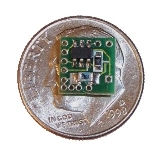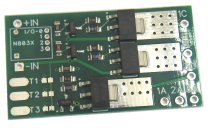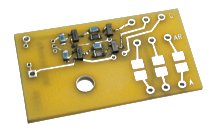Best viewed using:
Internet Explorer
or
Mozilla Firefox



Due to the wide variety of modeling scales, LEDs for use with these products are sold separately and can be found by clicking on the Lighting Products link at the left side of this page.
NEW LOW-VOLTAGE SIMULATORS SEE DETAILS BELOW
This simulator replicates the older-style signal and hazard warning flashers that used incandescent (filament) lamps to generate light. Typical flash rate of 3/4 second with a increasing and decreasing brightness curve to duplicate that of filament type lamps. Three outputs will each drive up to one pair (wired in series) of red and/or yellow LEDs Outputs flash sequentially so the module could also drive a very short series of "chase" lights.
Two new LOW-VOLTAGE
Simulator families
have been introduced: The NLA803X series for analog (DC) operation,
and the NLD803X
for DCC Sound decoders with 3.3-volt accessory
functions and RC applications that use 3.7-3.8 volt batteries. These
low-voltage versions have a wide effective input voltage range of
3.2 to 16 (maximum) volts DC.
To select a Simulator best suited for your
scale and type of operation click on "Which
Sim is best for me?" in the More Info table to
the right of each product description below.
This simulator provides a single
repeating burst, increasing and decreasing in intensity to accurately
represent roof beacons like those made by Prime and Federal used by most
railroads. The N8032 supports either yellow or red 20ma LEDs. The N8032A
is for white or blue LEDs,
and the N8032B has 2 selectable speeds.
| More Info |
| Connecting |
| Video coming soon |
|
As with the N8103 Booster Boards above, these Super Boosters come in 3 flavors: N8103A-1 to support a single output Simulator, N8103A-2 for 2 output Simulators, and N8103A-3 for 3-output Simulators. A Simulator is easily be piggybacked on a Booster Board (connecting wire included) and share a common power input for both. However, there are many modeling situations where a particular lighting effect may be desirable if it can be reproduced on many LEDs (series or parallel groups) or LEDs that exceed the 25mA or 5-volts DC. This is where our Booster Boards shine (forgive the pun). At just 0.8" x 1.50", these small boards increase a simulator's output up to times a Simulator's output and a DC voltage range of 9-18 VDC. This greatly expands the versatility of many of our Simulator products, especially where LEDs can be wired in series groups!
Our Simulator boards can also be programmed to perform as timer modules to
turn on and off outputs in timing ranges from seconds (or even
milli-seconds) to hours. When coupled with these Super Boosters a vary wide
range of control and automation can be performed.
Standard voltage operating range for the Super Booster Board is 6 to 18 volts DC. This voltage range is determined by the on-board voltage regulator mounted on our Simulator boards The Boosters come in 3 flavors: N8103-1 to support a single output Simulator (i.e., N8032 Beacon), N8103-2 for 2 output Simulators (i.e., N8038 Early-era Alternating Flasher), and N8103-3 for 3-output Simulators (i.e., N8043 Universal Strobe). A Simulator is easily be piggybacked on a Booster Board (connecting wire included) and share a common power input for both. This is the big brother of our Simulator Booster Boards. It is exactly the same size (0.8" x 1.50") as our N8103 product above, but has a much larger final-stage power transistor for the output. This allows a much wider range of control of many of our newer products like multiple sound modules or much larger groups of LEDs. It also allows driving much higher current LEDs for special lighting situations.
The tiny size of our Miniature Simulator modules above make them
extremely versatile for all modeling scales. However, this size also limits
output driving capability to 25mA at 5-volts DC per output channel. This is
sufficient to support a very wide range of lighting effects.
Super Booster Boards Simulator Booster Boards 
High current output boost plus added control solder points Supports up to 18VDC per output channel
 |
|
Custom Lighting Effect Simulators Do you need a special lighting effect that that no one produces or have a unique prototype requirement? We may be able to help. The N8050 will support 1 LED output, the N8051, 2 LED outputs, and the N8052 will support 3 LED outputs. For an additional programming charge (quoted separately), we will program the appropriate simulator to create your effect. Just email or call us with your requirements. We will review them, determine if they are within the capabilities of our simulator, and if so, respond with our quotation. Delivery can be within 2 weeks and our quote will be reasonable.
After approval and response to our quotation, add
appropriate item(s) to the shopping cart, then enter the agreed-upon
programming charge and add it to the shopping cart. Once we receive your
order, we will begin processing
|
| More Info N8042C |
| Which Sim is best for me? |
| Connecting N8042C |
| Connecting NLA/D8042C |
| LED Construction |
| Item# | Cart | Price |
| N8049C |
$14.95 |
|
| 2 or more | $11.95 each | |
| N8049D |
$14.95 |
|
| 2 or more | $11.95 each |
Cascadable Chase Light Simulator
This simulator will sequence 6 white or yellow-white LEDs in succession (1 through 6) then repeat over and over when input control is grounded (-DC). Unlike the chase light Simulator above, this version can be cascaded together for a virtually unlimited chase sequence. Click on Connecting in More Info (to the right) for details of wiring and operation. The N8049D version is for red, orange, and/or yellow LEDs.
| More Info |
| Connecting Arc |
| Connecting Gas |
| Video of effect |
Arc & Gas Welding Simulators
Finally, welding simulation that looks just like the real thing! A bit of shameless back-patting, but we believe it is warranted. These simulators are configured for connection of two LEDs to accurately reproduce the varying intensity, intermittence and slight color changes just like real welders. Our Nano LEDs are perfect for reproducing these effects. N8064 is the arc welder and N8064B is the gas welder. See Connecting under More Info to the right, for product details.
| Item# | Cart | Price |
| N8064 |
$13.95 |
|
| N8064B | $13.95 |
| More Info |
| Connecting |
| Video coming soon |
| Item# | Cart | Price |
| N8071 |
$14.95 |
|
| N8071B | $14.95 |
Tower Beacon/Strobe Simulator
The N8071 is configured to generate either a beacon effect (ramping up & down of brightness - the default setting), or a strobe effect for the primary (top of tower) red LED. Additionally, up to 4 more red or yellow LEDs can be connected which will run in a continuously-on state. This configuration allows this module to simulate the lighting of many different radio, cell and TV towers. The N8071B is configured for a primary (top of tower) white LED. This is typical for towers with a strobe light at top position.
How often have we seen a roof-mounted strobe-bar on a police vehicle from a mile or more away? Very eye-catching to say the least This circuit will sequence 6 LEDs in rapid strobe-like fashion, simulating the effects of typical police vehicle roof-mounted strobe bars. The configuration is quite dazzling in appearance and is intended for two white, two blue and two red (or yellow) LEDs. The N8072A is for two blue, two yellow & two red LEDs.
| Item# | Cart | Price |
| N8072 |
$14.95 |
|
| N8072A | $14.95 |
| More Info |
| Connecting |
| Video coming soon |
| Item# | Cart | Price |
| N8032 | $12.95 | |
| NLA8032 | $13.95 | |
| NLD8032 | $13.95 | |
| N8032A | $12.95 | |
| N8032B | $13.95 | |
| NLA8032A | $13.95 | |
| NLD8032A | $13.95 |
| More Info |
| Which Sim is best for me? |
| Connecting N8037 |
| Connecting NLA/D8037 |
| Video coming soon |
| Item# | Cart | Price |
| N8037 | $13.25 | |
| NLA8037 | $14.95 | |
| NLD8037 | $14.95 |
These modules reproduce a highly realistic simulation of rotating beacons by sequencing LEDs (sold separately) that are positioned to produce the effect. See the More Info table to the right for complete information. The N8042 is for a red or yellow 3-LED assembly. The timing of the rotational effect closely replicates that of rotating beacons seen on various aircraft including helicopters. The N8042A is the white-LED version. The N8042C is for a red or yellow 4-LED assembly that simulates the "gumball" type of rotating beacon.
| More Info |
| Which Sim is best for me? | >
| Connecting N8042/A |
| Connecting NLA/D8042/A |
| LED Construction |
| Video of effect |
| Item# | Cart | Price |
| N8042 |
$12.95 |
|
| NLA8042/A | $13.95 | |
| NLD8042/A | $13.95 | |
| N8042C | $13.95 | |
| NLA8042C | $14.95 | |
| NLD8042C | $14.95 |
This simulator will support strobe effects for a wide range of aircraft. The strobe pulse is a short 70ms burst occurring either once per second on all three outputs simultaneously, or when the simulator input is grounded, on two outputs together and one output separately, alternating at one-half second intervals . See Examples of use in the More Info table to the right for complete information.
| Item# | Cart | Price |
| N8043 |
$13.95 |
|
| NLA8043 | $14.95 | |
| NLD8043 | $14.95 |
| More Info |
| Which Sim is best for me? |
| Connecting N8043 |
| Connecting NLA/D8043 |
| Examples of use |
| Video of effect |
This simulator generates a rapid stream of pulses alternating between 2 connected LEDs whenever the input pin is grounded. The timing and duration of these pulses mimics the appearance of automatic weapons fire like that seen in WW2 and modern era wing and belly guns on planes and attack helicopters. The N8060A version of this module is configured for 4 LEDs alternating between pairs to simulate 4 guns firing.
| More Info |
| Which Sim is best for me? |
| Connecting N8049/A |
| Connecting NLA8049/A |
| Video coming soon |
6-LED Chase Light Simulator
This simulator will sequence 6 white LEDs in two different ways. With the input control pin left unconnected, LEDs will light in succession (1 through 6) then repeat over and over. This will simulate airport runway chase lights used for traffic landing assistance. With input control grounded (-DC), LEDs will sequence in an up and down fashion (1,2,3,4,5,6,5,4,3,2,1) and repeat over and over. The N8049A version is for red or yellow LEDs.
| Item# | Cart | Price |
| N8049 |
$14.95 |
|
| NLA8049 |
$15.95 |
|
| NLD8049 |
$15.95 |
|
| N8049A |
$14.95 |
|
| NLA8049A | $15.95 | |
| NLD8049A | $15.95 |
| More Info |
| Which Sim is best for me? |
| Connecting N8046 |
| Connecting NLA/D8046 |
| Adding "hot coals" |
| Video coming soon |
Furnace / Forge / Sawdust Burner Simulator
This module generates a slow, random undulating brightness output for either a single LED, or 2 series-wired LEDs. It closely replicates the exhaust glow of a jet engine being throttled up and down. The use of 2 LEDs gives double the light output. When strategically placed, it can create a reflective effect that can add significant realism to various aircraft. If used with our Nano LEDs, even the smallest scale model can benefit form the effect.
| Item# | Cart | Price |
| N8046 |
$13.95 |
|
| NLA8046 | $14.95 | |
| NLD8046 | $14.95 |
| Item# | Cart | Price |
| N8060 |
$13.95 |
|
| NLA8060 |
$14.95 |
|
| NLD8060 |
$14.95 |
|
| N8060A |
$13.95 |
|
| NLA8060A | $14.95 | |
| NLD8060A | $14.95 |
| More Info |
| Which Sim is best for me? |
| Connecting N8060/A |
| Connecting NLA/D8060/A |
| Video coming soon |
|
Machine Gun Simulator (WW1) his simulator generates a stream of pulses for a single LED whenever the input pin is grounded. The timing and duration of these pulses mimics the appearance of machine gun fire for early (slower rate) guns that were used on World War 1 aircraft. The "A" version is for two LEDs pulsing alternately to simulate two guns firing..
|
These modules generate various different effects to simulate aircraft navigation and running lights including strobes and beacons. Details of each Simulator's effects and instructions for connection are covered in the More info table to the right. Just click on each item Details for information.
| More Info |
| N8062 Details |
| N8062A/B Details |
| NLD8062 Details |
| NLD8062A/B Details |
| Video coming soon |
| Item# | Cart | Price |
| N8062 |
$14.95 |
|
| N8062A | $15.95 | |
| N8062B | $15.95 | |
| NLD8062 |
$15.95 |
|
| NLD8062A |
$16.95 |
|
| NLD8062B |
$16.95 |





















